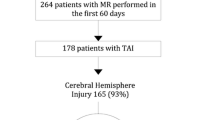Summary
Object. In 1991 a new pioneering classification of severe head injuries had been proposed, based on CT findings. Unfortunately CT cannot visualise all lesions. Especially brain stem lesions may escape CT in spite of modern equipment, but may be demonstrated by MRI. The high incidence of CT negative but MRI positive posttraumatic brain stem lesions has already been demonstrated in a limited number of cases. A statistically significant evaluation is still missing. Therefore we have investigated a series of 102 comatose patients, in whom a statistical evaluation of MRI findings and their correlation with mortality and outcome of survivors was possible.
Patients and Methods. MRI was obtained within 8 days after servere head injury in 102 patients with a minimum of 24 hours of coma. The location of the lesions, identified by a neuroradiologist who was unaware of the clinical findings, was correlated with mortality, outcome of surviors and duration of coma. The correlation was analysed statistically. Follow-up ranged from 3 months to 3 years with a mean of 22 months.
Four groups of lesions gave significant correlations:
Grade I lesions were lesions of the hemispheres only;
Grade II lesions were unilateral lesions of the brain stem at any level with or without supratentorial lesions;
Grade III lesions were bilateral lesions of the mesencephalon with or without supratentorial lesions.
Grade IV lesions were bilateral lesion of the pons with or without any of the foregoing lesions of lesser grades.
Results. Mortality increased from 14% in grade I lesions to 100% in grade IV lesions. The Glasgow outcome score differed significantly for each grade. The mean duration of coma increased from 3 days in grade I patients to 13 days in grade III. The correlations between the lesions grade I to IV with mortality, outcome of survivors and duration of coma were highly significant.
Conclusion. The statistically significant correlations between the 4 groups of severe head injury patients, as identified by MRI, with mortality and outcome of survivors justify a new classification based on early MRI findings.
Similar content being viewed by others
Author information
Authors and Affiliations
Rights and permissions
About this article
Cite this article
Firsching, R., Woischneck, D., Klein, S. et al. Classification of Severe Head Injury Based on Magnetic Resonance Imaging. Acta Neurochir (Wien) 143, 263–271 (2001). https://doi.org/10.1007/s007010170106
Issue Date:
DOI: https://doi.org/10.1007/s007010170106




